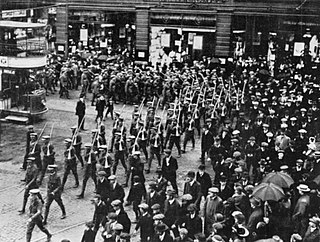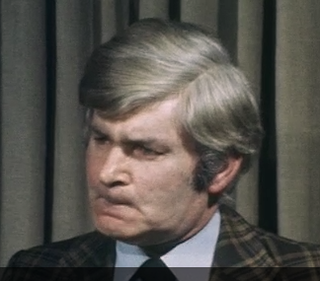Related Research Articles

Ian Richard Kyle Paisley, Baron Bannside, was a Northern Irish loyalist politician and Protestant religious leader who served as leader of the Democratic Unionist Party (DUP) from 1971 to 2008 and First Minister of Northern Ireland from 2007 to 2008.

The Ulster Special Constabulary was a quasi-military reserve special constable police force in Northern Ireland. It was set up in October 1920, shortly before the partition of Ireland. It was an armed corps, organised partially on military lines and called out in times of emergency, such as war or insurgency. It performed this role most notably in the early 1920s during the Irish War of Independence and the 1956-1962 IRA Border Campaign.

The Ulster Defence Regiment (UDR) was an infantry regiment of the British Army established in 1970, with a comparatively short existence ending in 1992. Raised through public appeal, newspaper and television advertisements, their official role was the "defence of life or property in Northern Ireland against armed attack or sabotage" but unlike troops from Great Britain they were never used for "crowd control or riot duties in cities". At the time the UDR was the largest infantry regiment in the British Army, formed with seven battalions plus another four added within two years.
The Ulster Loyalist Central Co-ordinating Committee (ULCCC) was set up in 1974 in Belfast, Northern Ireland in the aftermath of the Ulster Workers Council Strike, to facilitate meetings and policy coordination between the Ulster Workers Council, loyalist paramilitary groups, and the political representatives of Ulster loyalism.
The Ulster Workers' Council was a loyalist workers' organisation set up in Northern Ireland in 1974 as a more formalised successor to the Loyalist Association of Workers (LAW). It was formed by shipyard union leader Harry Murray and initially failed to gain much attention. However, with the full support of the Ulster Defence Association (UDA) the UWC became the main mobilising force for loyalist opposition to power-sharing arrangements.
The United Ulster Unionist Council was a body that sought to bring together the Unionists opposed to the Sunningdale Agreement in Northern Ireland.
The Ulster Army Council of Northern Ireland was set up in 1973 as an umbrella group by the Ulster Defence Association and the Ulster Volunteer Force to co-ordinate joint paramilitary operations during the Ulster Workers' Council Strike. Andy Tyrie was the head of the group – and was also the then commander of the Ulster Defence Association.

The Ulster Volunteers was a unionist, loyalist militia founded in 1912 to block domestic self-government for Ireland, which was then part of the United Kingdom. The Ulster Volunteers were based in the northern province of Ulster. Many Ulster Protestants and Irish unionists feared being governed by a nationalist Catholic-majority parliament in Dublin and losing their links with Great Britain. In 1913, the militias were organised into the Ulster Volunteer Force (UVF) and vowed to resist any attempts by the British Government to impose Home Rule on Ulster. Later that year, Irish nationalists formed a rival militia, the Irish Volunteers, to safeguard Home Rule. In April 1914, the UVF smuggled 25,000 rifles into Ulster from Imperial Germany. The Home Rule Crisis was interrupted by the First World War. Much of the UVF enlisted with the British Army's 36th (Ulster) Division and went to fight on the Western Front.

The Loyal Orange Institution, commonly known as the Orange Order, is an international Protestant fraternal order based in Northern Ireland and primarily associated with Ulster Protestants, particularly those of Ulster Scots heritage. It also has lodges in England, Scotland and the Republic of Ireland, as well as in parts of the Commonwealth of Nations, Togo and the United States. The Orange Order was founded by Ulster Protestants in County Armagh in 1795, during a period of Protestant–Catholic sectarian conflict, as a fraternity sworn to maintain the Protestant Ascendancy in Ireland. It is headed by the Grand Orange Lodge of Ireland, established in 1798. Its name is a tribute to the Dutch-born Protestant king William of Orange, who defeated Catholic king James II in the Williamite–Jacobite War (1688–1691). The order is best known for its yearly marches, the biggest of which are held on or around 12 July, a public holiday in Northern Ireland.

Ulster Resistance (UR), or the Ulster Resistance Movement (URM), is an Ulster loyalist paramilitary movement established by Ulster loyalists in Northern Ireland on 10 November 1986 in opposition to the Anglo-Irish Agreement.

Operation Banner was the operational name for the British Armed Forces' operation in Northern Ireland from 1969 to 2007, as part of the Troubles. It was the longest continuous deployment in British military history. The British Army was initially deployed, at the request of the unionist government of Northern Ireland, in response to the August 1969 riots. Its role was to support the Royal Ulster Constabulary (RUC) and to assert the authority of the British government in Northern Ireland. This involved counter-insurgency and supporting the police in carrying out internal security duties such as guarding key points, mounting checkpoints and patrols, carrying out raids and searches, riot control and bomb disposal. More than 300,000 soldiers served in Operation Banner. At the peak of the operation in the 1970s, about 21,000 British troops were deployed, most of them from Great Britain. As part of the operation, a new locally-recruited regiment was also formed: the Ulster Defence Regiment (UDR).

John Dunlop McKeague was a prominent Ulster loyalist and one of the founding members of the paramilitary group the Red Hand Commando in 1970. Authors on the Troubles in Northern Ireland have accused McKeague of involvement in the Kincora Boys' Home scandal but he was never convicted. He was shot dead by the Irish National Liberation Army (INLA) in Belfast in January 1982.

William McCaughey was a member of the Royal Ulster Constabulary's Special Patrol Group and the illegal Ulster Volunteer Force's Glennane gang in the 1970s. He was imprisoned for 16 years for murder from 1980 to 1996. On his release he worked as a loyalist and Orange Order activist until his death in 2006.
The Reavey and O'Dowd killings were two co-ordinated gun attacks on 4 January 1976 in County Armagh, Northern Ireland. Six Catholic civilians died after members of the Ulster Volunteer Force (UVF), an Ulster loyalist paramilitary group, broke into their homes and shot them. Three members of the Reavey family were shot at their home in Whitecross and four members of the O'Dowd family were shot at their home in Ballydougan. Two of the Reaveys and three of the O'Dowds were killed outright, with the third Reavey victim dying of brain hemorrhage almost a month later.
George Green was a unionist politician in Northern Ireland.

The Tullyvallen massacre took place on 1 September 1975, when Irish republican gunmen attacked an Orange Order meeting hall at Tullyvallen, near Newtownhamilton in County Armagh, Northern Ireland. The Orange Order is an Ulster Protestant and unionist brotherhood. Five Orangemen were killed and seven wounded in the shooting. The "South Armagh Republican Action Force" claimed responsibility, saying it was retaliation for a string of attacks on Catholic civilians by Loyalists. It is believed members of the Provisional IRA carried out the attack, despite the organisation being on ceasefire.
Down Orange Welfare was an Ulster loyalist paramilitary vigilante group active in Northern Ireland during the 1970s. Operating in rural areas of County Down, the group faded after failing to win support away from larger groups such as the Ulster Defence Association (UDA) and Ulster Volunteer Force (UVF).
The Orange Volunteers (OV) was a loyalist vigilante group with a paramilitary structure active in Northern Ireland during the early 1970s. It took its name from the Orange Order, from which it drew the bulk of its membership.
The Ulster Special Constabulary Association (USCA) was a loyalist group active in Northern Ireland during the early 1970s.
The Ulster Volunteer Service Corps (UVSC) was an Ulster loyalist vigilante and paramilitary movement active in Northern Ireland during the early 1970s. Initially the steward group for the Ulster Vanguard, under the title Vanguard Service Corps, it continued to exist after becoming independent of that movement.
References
- 1 2 Steve Bruce, The Red Hand, Oxford University Press, 1992, p. xii
- 1 2 Henry Patterson, Eric P. Kaufmann, Unionism and Orangeism in Northern Ireland Since 1945: The Decline of the Loyal Family, Manchester University Press, 2007, p. 185
- 1 2 3 4 W.D. Flackes & Sydney Elliott, Northern Ireland A Political Directory 1968-1993, The Blackstaff Press, 1994, p. 336
- ↑ Eric P. Kaufmann, The Orange Order: A Contemporary Northern Irish History, Oxford University Press, 2007, p. 105
- ↑ Wood, Ian S., Crimes of Loyalty: A History of the UDA, Edinburgh University Press, 2006, p. 64
- ↑ Wood, Crimes of Loyalty, pp. 64-65
- ↑ Yonah Alexander, Alan O'Day, Ireland's Terrorist Dilemma, Martinus Nijhoff Publishers, 1986, p. 259
- ↑ Flackes & Elliott, Northern Ireland, p. 346